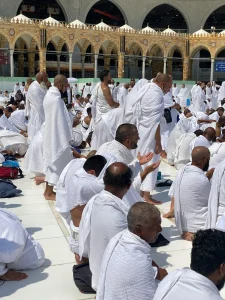THE GARMENT OF IHRAM: A REMINDER OF DEATH AND EQUALITY

When a pilgrim enters the sacred state of Ihram, everything changes. The heart trembles, the soul softens, and the world suddenly feels distant. The moment those two simple white garments are wrapped around the body, every symbol of status, pride, and worldly identity is stripped away. You are no longer defined by your wealth, your titles, or your position you stand before Allah as nothing more than a servant, equal to every other soul around you.
THE GARMENT THAT STRIPS AWAY THE WORLD
Ihram is not merely clothing; it is a statement of surrender. It symbolizes the believer’s detachment from worldly possessions and ego, and their readiness to meet Allah with humility and sincerity. When one wears the Ihram, there are no labels, no brands, no ranks only purity, simplicity, and submission.
In that sacred moment, the rich and the poor, the ruler and the servant, the known and the unknown all look the same. Every pilgrim utters the same Talbiyah:
“Labbayk Allahumma Labbayk, Labbayk Laa Shareeka Laka Labbayk.”
(Here I am, O Allah, here I am. Here I am, You have no partner, here I am.)
The white sheets of Ihram are a powerful visual reminder that before Allah, we are all equal united not by wealth or appearance, but by faith and devotion.
A REMINDER OF DEATH AND THE FINAL JOURNEY
One of the most profound reflections during Hajj is that the garment of Ihram resembles the kafan the simple white shroud in which every Muslim will one day be buried. When the pilgrim dons the Ihram, it is as if they are rehearsing for their final return to Allah.
You leave behind your home, your comfort, and your luxury just as you will one day leave this world. You stand before Allah in humility, just as you will on the Day of Judgment. Ihram, therefore, is not only an act of worship but a spiritual awakening. It whispers to the soul:
“You came from dust, and to dust you shall return.”
This realization softens the heart, reminding us of our mortality and the fleeting nature of this world. It humbles the believer and inspires repentance, sincerity, and renewed purpose.
EQUALITY IN THE EYES OF ALLAH
The sight of millions of pilgrims, all dressed in the same unstitched white cloth, moving together in worship, is one of the most powerful symbols of unity in existence. There are no distinctions of race, nationality, or social class only servants of Allah, standing shoulder to shoulder, saying the same words, seeking the same mercy.
It is a living expression of the Prophet Muhammad ﷺ’s final sermon, where he declared:
“No Arab is superior to a non-Arab, and no non-Arab is superior to an Arab. No white man is superior to a black man, and no black man is superior to a white man except by piety.”
(Ahmad)
In Ihram, all worldly hierarchies vanish. It reminds the believer that what truly elevates a person is not what they own or where they come from but the state of their heart before Allah.
THE INNER IHRAM: PURITY OF INTENTION
Wearing Ihram externally is only part of the journey; the greater challenge is to enter Ihram internally to purify the heart of arrogance, envy, and resentment. The physical garment must reflect an inner state of submission and sincerity.
True Ihram is not only what you wear but what you let go of: anger, ego, grudges, and worldly attachments. It is a cleansing of both the body and the soul preparing you to stand before the Lord in your most truthful form.
CONCLUSION
The garment of Ihram is more than fabric it is a message. It teaches that life is temporary, that death is certain, and that in the end, all that remains is your relationship with Allah.
When you put on the Ihram, you are reminded of your beginning and your end of who you are and where you are going. It strips away illusion and returns you to the essence of servitude.
Every pilgrim who wears it is walking not just toward Makkah, but toward self-realization toward humility, equality, and the eternal truth that before Allah, all are the same.

